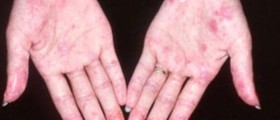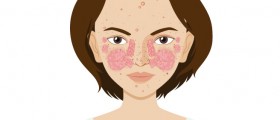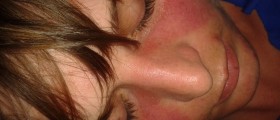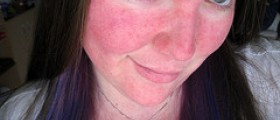Butterfly rash (medically known as malar rash) is a specific medical sign and a type of rash. It affects the face, is red or purplish and mildly scaly. Butterfly rash has sharp edges and is not itchy. The very name "butterfly" originates from the specific pattern of the rash. Namely, it affects the bridge of the nose and the cheeks and its shape resembles a butterfly. Apart from the characteristic appearance butterfly rash may spread to other parts of the face and lose its shape.
What Are Causes of Butterfly Rash?
In majority of cases butterfly rash occurs in patients suffering from lupus. It is estimated that approximately 46-65% patients with lupus develop characteristic butterfly rash. This type of rash affects both, patients suffering from discoid lupus erythematosus (the condition localized to the skin) and systemic lupus erythematosus (systemic autoimmune disease). In discoid lupus erythematosus only the skin is affected by the autoimmune process. The rash on the face is scaly and red. In systemic lupus erythematosus apart from skin changes the disease can affect different organs and organ systems as well. The most commonly affected organs include kidneys, liver, brain and blood vessels.
It is essential to mention that in spite of commonly affecting people suffering from lupus butterfly rash is not pathognomonic, meaning that it can also develop in several more medical conditions. For example, it occurs in people suffering from pellagra (chronic lack of vitamin B3-niacin), dermatomyositis and Bloom syndrome. Furthermore butterfly rash can also be a characteristic for rosacea. In such case the rash is red and affects the cheeks, nose and also spreads to the forehead. Inflammation of the skin and formation of bumps are two more characteristics of butterfly rash in rosacea. And finally, butterfly rash may also develop in people suffering from erysipelas. This is a skin infection caused by Streptococcus bacteria. It generally affects the lower limbs but it may develop on the face as well.
Treatment for Butterfly Rash
In patients suffering from lupus there is no cure for butterfly rash as well as other symptoms. However, the condition can be brought under control with several medications. It is essential not to expose the face to the sun because the rash will only get worse. In discoid lupus patients may benefit from antiinflammatory and antimalarial drugs. Systemic lupus erythematosus requires more aggressive treatment with oral corticosteroids. And finally, if butterfly rash occurs due to other medical conditions such as pellagra, erysipelas or rosacea it can completely withdraw once the underlying condition is brought under control.

















Your thoughts on this
Loading...